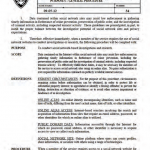
Data contained within social network sites may assist law enforcement in gathering timely information in furtherance of crime prevention, preservation of public order, and the investigation of criminal activity, including suspected terrorist activity. These guidelines are promulgated, in part, to instill the proper balance between the investigative potential of social network sites and privacy expectations.
